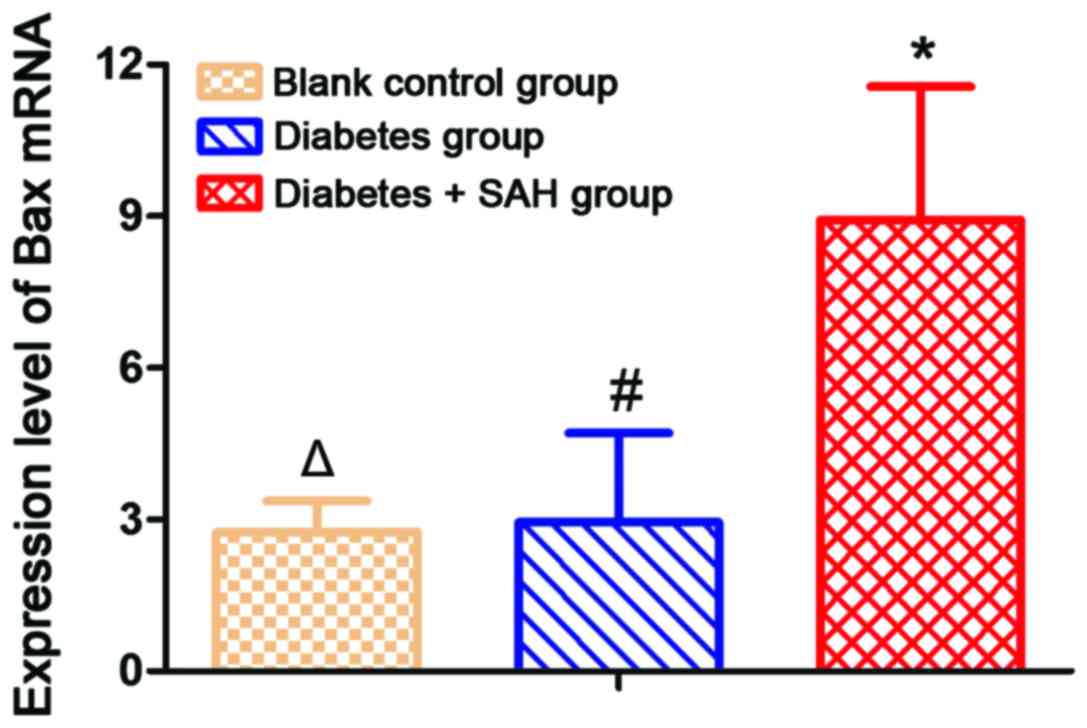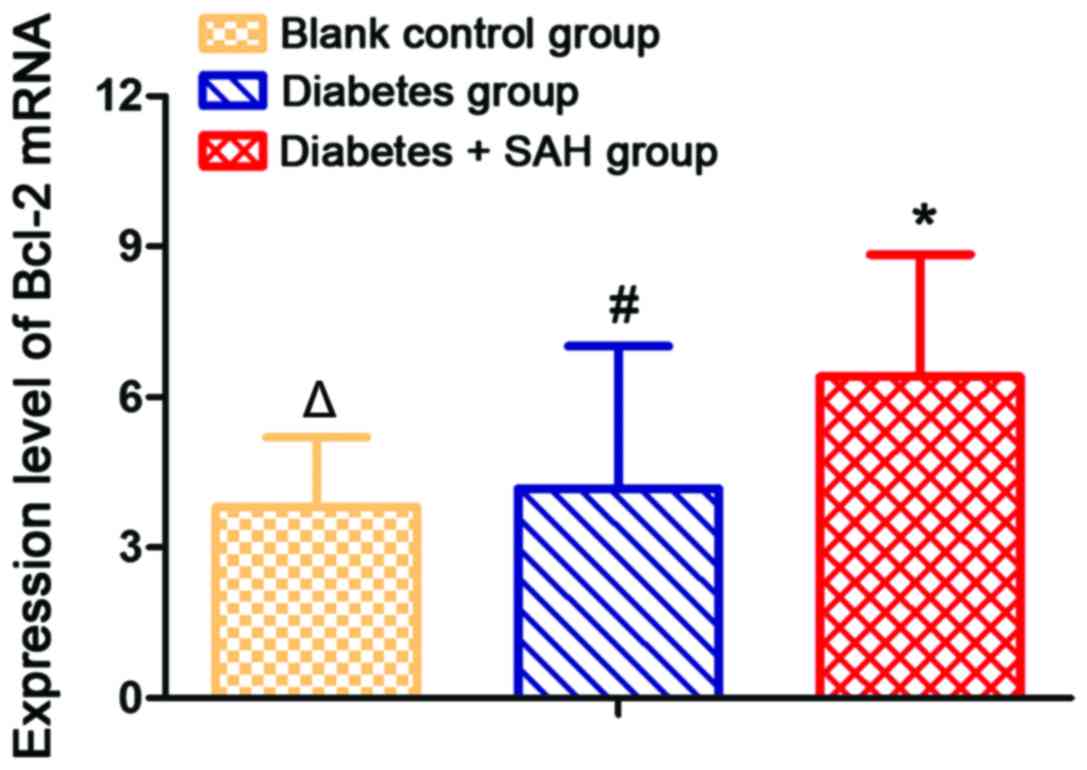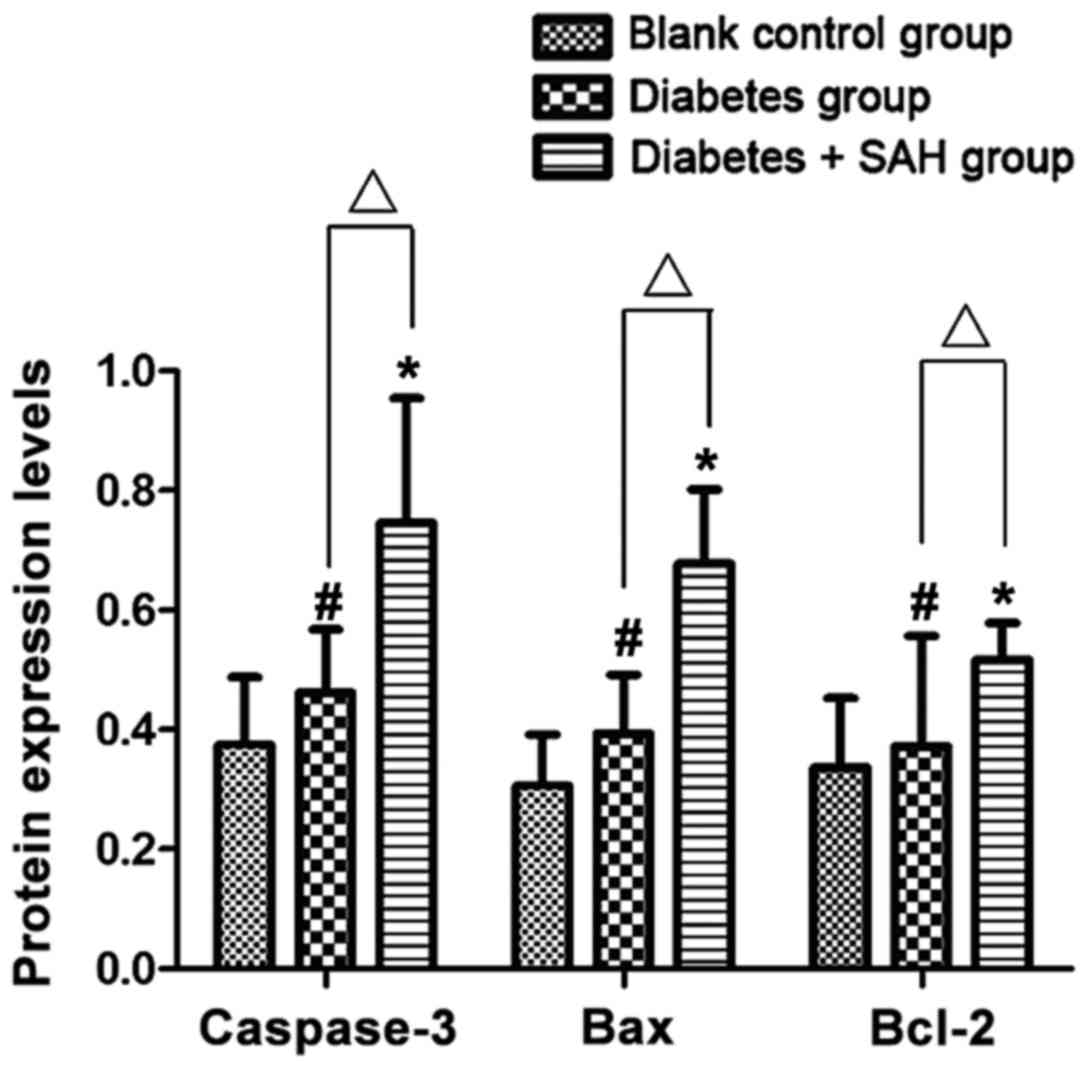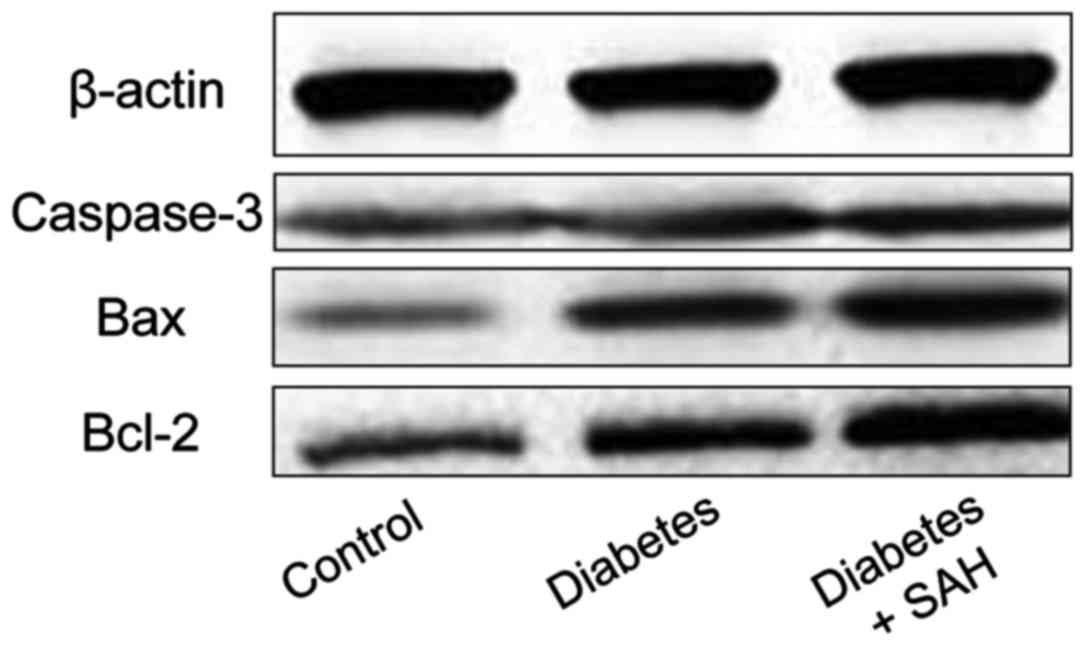Expression of caspase-3, Bax and Bcl-2 in hippocampus of rats with diabetes and subarachnoid hemorrhage
Retraction in: /10.3892/etm.2024.12704
- Authors:
- Published online on: November 3, 2017 https://doi.org/10.3892/etm.2017.5438
- Pages: 873-877
-
Copyright: © He et al. This is an open access article distributed under the terms of Creative Commons Attribution License.
Abstract
Introduction
Subarachnoid hemorrhage (SAH) refers to the syndrome caused by the entering of blood into intracranial or spinal canal subarachnoid spaces after intracranial vascular rupture, which are caused by various factors (1). It is reported that SAH accounted for about 5% of cerebrovascular diseases (2). About 13% of patients will die with effective clinical treatment in the early stages of bleeding (3,4). In recent years, with the gradually increased incidence of diabetes, number of patients with diabetes and SAH also showed an increasing trend. It has been reported that SAH patients with diabetes had a significantly higher risk of lethality than SAH patients without diabetes mellitus, which brought difficulties to clinical treatment. Neuronal apoptosis plays an important role in the pathogenesis of SAH (5). Caspase-3 is one of the major effectors of apoptosis, and activation of caspase-3 indicates irreversible cell apoptosis (6). Bax and Bcl-2 are apoptotic and anti-apoptotic proteins, respectively, and the ratio of those two proteins determines the occurrence of cell apoptosis (7). In this study, expression levels of apoptosis-related factors in hippocampus of SAH rats combined with diabetes were detected. Our study provided experimental evidence for further study of the relationship between SAH and cell apoptosis.
Subjects and methods
Subjects
Experimental subjects
Thirty-nine SPF grade adult male Sprague-Dawley (SD) rats (275±25 g) were purchased from BetterBiotechnology Co., Ltd. (Nanjing, China). Rats were divided into three groups: 9 rats in blank control group, 15 rats in diabetes control group and 15 rats in diabetes + SAH group. The study was approved by the Ethics Committee of Anyang District Hospital.
Experimental reagents and material
STZ (Lianshuo Biological Technology Co., Shanghai, China), TUNEL detection kit (KeyGen Biotech. Co. Ltd., Nanjing, China), RNA extraction kit (Lengtonbio, Co., Ltd., Shanghai, China), cDNA synthesis kit (Shanghai Well Industries Co., Ltd., Shanghai, China), Real-time PCR (RT-PCR) and Western Blot Assay kit (BestBio, Shanghai, China), BCA protein quantitative kit (Nanjing SenBeijia Biotechnology Co., Ltd., Nanjing, China), rabbit anti-rat caspase-3, Bax and Bcl-2, β-actin polyclonal antibodies, goat anti-rabbit IgG H&L polyclonal antibody (dilution, 1:1,000; cat nos. ab13847, ab32503, ab59348, ab8227 and ab6721; Abcam, Cambridge, MA, USA).
Experimental methods
Establishment of experimental animal model
Intraperitoneal injection of STZ was used to establish diabetes model. Blood glucose was continuously detected and blood glucose level higher than 16.7 mmol/l indicates the successfully established model. After the establishment of diabetes model, SAH animal model was established by injecting fresh autologous femoral artery blood into cerebellomedullary cisten, according to the methods described by Lu et al (8). After the establishment of SAH model, experimental animals were anesthetized at 12, 24 and 48 h, and hippocampus was removed and stored in liquid nitrogen. Five rats from diabetes group and diabetes + SAH group were processed at each time point, and hippocampus tissue collected at 24 after the establishment of SAH model was used for RT-PCR and western blot experiments.
TUNEL method to detect cell apoptosis
Hippocampus was embedded with paraffin. After that, paraffin-embedded tissue was cut into sections with a thickness of about 4 µm. After dewaxing, hydration was performed. In situ tissue apoptosis was detected according to the instructions of TUNEL kit. Apoptotic cells in the hippocampus of rats with diabetes and SAH showed brownish color under light microscope. Ten visual fields were randomly selected under Leica DMi8 microscope, and the number of apoptotic cells was counted.
RT-PCR to detect mRNA expression
Total RNA was extracted according to the instructions of the kit. Concentration and purity of mRNA samples were measured by spectrophotometer. Only the samples with ratio of OD260/OD280 between 1.8 and 2.0 were used. All primers used here were synthesized by Western Biotechnology Inc. Primer sequences are listed in Table I. cDNA was synthesized using reverse transcription with a system of 20 µl.
RT-PCR reaction system: 25 µl, reaction conditions: 95°C for 30 sec, followed by 40 cycles of 95°C for 5 sec, 60°C for 30 sec and 72°C for 60 seconds. With β-actin as endogenous control, expression levels of caspase-3, Bax and Bcl-2 were calculated using automatic output by RT-PCR machine (Thermo Fisher Scientific, Waltham, MA, USA).
Western blot analysis to detect protein expression
Total protein was extracted according to the instructions of kit and protein concentration was measured by BCA protein quantification method. Protein samples were stored at −70°C before use. Gel electrophoresis was performed with 10% separation gel and 5% concentration gel. Positions of two proteins were determined according to the bands of marker. After transmembrane, membrane was washed with TBST solution for 5 min. After blocking with 5% skim milk at room temperature for 1 h, membrane was cultured with primary antibody (1:1,000) at room temperature overnight. After that, membrane was washed 3 times with TBST (5 min each time), followed by incubation with secondary antibody (1:1,000) at room temperature for 1 h. Membrane was then washed 3 times with TBST (5 min each time). Then, color development was performed using ECL luminescent liquid in dark for 2 min. Finally, results were scanned using Multi Gauge Ver.3.0 imaging system, and ImageJ professional image analysis software was used for image analysis and OD value was recorded.
Statistical analysis
Data were analyzed by SPSS 17.0 software (SPSS, Inc., Chicago, IL, USA). All data were expressed as mean ± standard deviation. Single factor variance test was performed for comparisons among multiple groups and comparisons between two groups were performed using least significant difference t-test, α=0.05 was used as test standard.
Results
Results of cell apoptosis detection
TUNEL method was used to detect cell apoptosis. Nuclei of apoptotic cells in hippocampus showed brownish color, karyopycnosis was observed, and most of the cells showed round shape. No TUNEL-positive cells were found in blank control group and diabetes group. Number of positive cells in diabetes + SAH group began to increase (68.33±8.39) at 12 h after model establishment, number of positive cells reached the peak at 24 h (217.44±33.51), apoptotic cells can also be detected at 48 h, but the number decreased (103.47±18.95). Significant differences of number of positive cells were observed between diabetes + SAH group and blank control group and diabetes group (p<0.01) (Fig. 1).
RT-PCR results
Results of RT-PCR showed that expression level of caspase-3 mRNA was significantly increased in diabetes group (2.59±2.04) and diabetes + SAH group (8.14±2.79) compared with blank control group (2.14±0.96) (p<0.05). Expression level of caspase-3 mRNA was significantly higher in diabetes + SAH group than in diabetes group (Fig. 2).
Expression level of Bax mRNA was significantly increased in diabetes + SAH group (8.92±2.61) and diabetes group (2.94±1.77) compared with blank control group (2.75±0.61) (p<0.05). Expression level of Bax mRNA was significantly higher in diabetes + SAH group than in diabetes group (Fig. 3).
Expression level of Bcl-2 mRNA was significantly increased in diabetes + SAH group (6.41±2.43) and diabetes group (4.17±2.85) compared with blank control group (3.82±1.38) (p<0.05). In addition, expression level of Bcl-2 mRNA was significantly higher in diabetes + SAH group than in diabetes group (Fig. 4).
Results of western blot analysis
Western blot results showed that expression level of caspase-3 protein in diabetes + SAH group (0.746±0.209) was significantly higher than that in blank control group (0.375±0.113) and diabetes group (0.462±0.106) (p<0.05); expression level of Bax protein in diabetes + SAH group (0.678±0.124) was significantly higher than that in blank control group (0.306±0.086) and diabetes group (0.394±0.098) (p<0.05); expression level of Bcl-2 protein in diabetes + SAH group (0.517±0.062) was significantly higher than that in blank control group (0.337±0.116) and diabetes group (0.372±0.185) (p<0.05) (Figs. 5 and 6).
Discussion
Incidence of SAH combined with diabetes shows an increasing trend (9). It has been reported that hyperglycemia can cause increased neuronal damage in hippocampus of SAH, resulting in increased neuronal necrosis and increased infarction size (10,11). In the event of SAH, apoptosis of a variety of types of cells, such as vascular endothelial cells (12), neuronal cells (13) and other cells will occur. Caspase-3, which is the convergence point of the apoptotic signaling pathway, is a common part of various apoptotic signaling pathways. Once caspase-3 was activated, apoptotic pathway was initiated (14,15). Bax can activate some small molecules to enter into cytoplasm, resulting in cell apoptosis (16). Bcl-2 is an anti-apoptotic protein that can compete against Bax to play its anti-apoptotic function (17).
In this study, diabetes + SAH animal model was established by injecting fresh autologous femoral artery blood into cerebellomedullary cisten. Cell apoptosis detected by TUNEL method showed that number of apoptotic cells in diabetes + SAH group reached the peak at 24 h after model establishment, while almost no apoptotic cells were detected in blank control group and diabetes group, and significant difference were found between diabetes + SAH group and blank control group and diabetes group. RT-PCR results showed that expression levels of caspase-3, Bax and Bcl-2 mRNA in diabetes + SAH group was significantly higher than that in blank control group and diabetes group. Western blot showed that expression levels of three proteins were significantly higher in diabetes + SAH group than in blank control group and diabetes group, indicating that Bax has pro-apoptotic function in cells (18), whereas Bcl-2 exhibits the opposite function to Bax, that is, anti-apoptotic function (19). Apoptosis rate is inversely proportional to the expression level of Bcl-2 (20). Therefore, we hypothesized that the ratio of Bax to Bcl-2 was significantly increased (0.678/0.517=1.311) at 24 h after model establishment in diabetes + SAH group, resulting in cell apoptosis.
Pathological mechanism of central nervous system injury of patients with diabetes and SAH is very complicated. In this study, only the expression levels of apoptosis-related factors including caspase-3, Bax and Bcl-2 in hippocampus were investigated, while the specific mechanism remains to be studied. This study can be used as experimental basis for further studies on the relationship between SAH and cell apoptosis.
References
|
Li S, Xiao X, Ni X, Ye Z, Zhao J and Hang C: Tetramethylpyrazine protects against early brain injury after experimental subarachnoid hemorrhage by affecting mitochondrial-dependent caspase-3 apoptotic pathway. Evid Based Complement Alternat Med. 2017:35149142017.PubMed/NCBI | |
|
Fujii M, Sherchan P, Soejima Y, Hasegawa Y, Flores J, Doycheva D and Zhang JH: Cannabinoid receptor type 2 agonist attenuates apoptosis by activation of phosphorylated CREB-Bcl-2 pathway after subarachnoid hemorrhage in rats. Exp Neurol. 261:396–403. 2014. View Article : Google Scholar : PubMed/NCBI | |
|
Wang J, Wang JF and Hu XM: Caspase-3 in serum predicts outcome after aneurysmal subarachnoid hemorrhage. Clin Chim Acta. 460:196–202. 2016. View Article : Google Scholar : PubMed/NCBI | |
|
Li H, Yu JS, Zhang HS, Yang YQ, Huang LT, Zhang DD and Hang CH: Increased expression of caspase-12 after experimental subarachnoid hemorrhage. Neurochem Res. 41:3407–3416. 2016. View Article : Google Scholar : PubMed/NCBI | |
|
Edebali N, Tekin IÖ, Açıkgöz B, Açıkgöz S, Barut F, Sevinç N and Sümbüloğlu V: Apoptosis and necrosis in the circumventricular organs after experimental subarachnoid hemorrhage as detected with annexin V and caspase 3 immunostaining. Neurol Res. 36:1114–1120. 2014. View Article : Google Scholar : PubMed/NCBI | |
|
Yu ZQ, Jia Y and Chen G: Possible involvement of cathepsin B/D and caspase-3 in deferoxamine-related neuroprotection of early brain injury after subarachnoid haemorrhage in rats. Neuropathol Appl Neurobiol. 40:270–283. 2014. View Article : Google Scholar : PubMed/NCBI | |
|
Maione AG, Brudno Y, Stojadinovic O, Park LK, Smith A, Tellechea A, Leal EC, Kearney CJ, Veves A, Tomic-Canic M, et al: Three-dimensional human tissue models that incorporate diabetic foot ulcer-derived fibroblasts mimic in vivo features of chronic wounds. Tissue Eng Part C Methods. 21:499–508. 2015. View Article : Google Scholar : PubMed/NCBI | |
|
Lu H, Shi JX, Chen HL, Hang CH, Wang HD and Yin HX: Expression of monocyte chemoattractant protein-1 in the cerebral artery after experimental subarachnoid hemorrhage. Brain Res. 1262:73–80. 2009. View Article : Google Scholar : PubMed/NCBI | |
|
Simard JM, Tosun C, Ivanova S, Kurland DB, Hong C, Radecki L, Gisriel C, Mehta R, Schreibman D and Gerzanich V: Heparin reduces neuroinflammation and transsynaptic neuronal apoptosis in a model of subarachnoid hemorrhage. Transl Stroke Res. 3 Suppl 1:155–165. 2012. View Article : Google Scholar : PubMed/NCBI | |
|
Cai J, Cao S, Chen J, Yan F, Chen G and Dai Y: Progesterone alleviates acute brain injury via reducing apoptosis and oxidative stress in a rat experimental subarachnoid hemorrhage model. Neurosci Lett. 600:238–243. 2015. View Article : Google Scholar : PubMed/NCBI | |
|
Yunchang M, Qinxue D, Binbin J, Xin H, Lili Y, Linbi C, Wujun G, Pengbo Z and Junlu W: Human tissue kallikrein ameliorates cerebral vasospasm in a rabbit model of subarachnoid hemorrhage. Neurol Res. 37:1082–1089. 2015. View Article : Google Scholar : PubMed/NCBI | |
|
Han Y, Zhang T, Su J, Zhao Y, Chenchen Wang and Li X: Apigenin attenuates oxidative stress and neuronal apoptosis in early brain injury following subarachnoid hemorrhage. J Clin Neurosci. 40:157–162. 2017. View Article : Google Scholar : PubMed/NCBI | |
|
Zhang H, Xu R, Xie F, Xu W, Zeng MF, Wang X and Zhu J: Protective effects of perfluorooctyl-bromide nanoparticles on early brain injuries following subarachnoid hemorrhage in rats. Am J Transl Res. 7:1404–1416. 2015.PubMed/NCBI | |
|
Goksu E, Dogan O, Ulker P, Tanrıover G, Konuk E, Dilmac S, Kirac E, Demır N and Aslan M: Pentoxifylline alleviates early brain injury in a rat model of subarachnoid hemorrhage. Acta Neurochir (Wien). 158:1721–1730. 2016. View Article : Google Scholar : PubMed/NCBI | |
|
Yin C, Huang GF, Sun XC, Guo Z and Zhang JH: Tozasertib attenuates neuronal apoptosis via DLK/JIP3/MA2K7/JNK pathway in early brain injury after SAH in rats. Neuropharmacology. 108:316–323. 2016. View Article : Google Scholar : PubMed/NCBI | |
|
Fujii M, Sherchan P, Soejima Y, Doycheva D and Zhang JH: Subarachnoid hemorrhage-triggered acute hypotension is associated with left ventricular cardiomyocyte apoptosis in a rat model. Acta Neurochir Suppl (Wien). 121:145–150. 2016. View Article : Google Scholar | |
|
Chen J, Qian C, Duan H, Cao S, Yu X, Li J, Gu C, Yan F, Wang L and Chen G: Melatonin attenuates neurogenic pulmonary edema via the regulation of inflammation and apoptosis after subarachnoid hemorrhage in rats. J Pineal Res. 59:469–477. 2015. View Article : Google Scholar : PubMed/NCBI | |
|
Erşahin M, Ozsavcı D, Sener A, Ozakpınar OB, Toklu HZ, Akakin D, Sener G and Yeğen BÇ: Obestatin alleviates subarachnoid haemorrhage-induced oxidative injury in rats via its anti-apoptotic and antioxidant effects. Brain Inj. 27:1181–1189. 2013. View Article : Google Scholar : PubMed/NCBI | |
|
Tso MK, Lass E, Ai J and Loch Macdonald R: Valproic acid treatment after experimental subarachnoid hemorrhage. Acta Neurochir (Suppl). 120:81–85. 2015.PubMed/NCBI | |
|
Topkoru BC, Altay O, Duris K, Krafft PR, Yan J and Zhang JH: Nasal administration of recombinant osteopontin attenuates early brain injury after subarachnoid hemorrhage. Stroke. 44:3189–3194. 2013. View Article : Google Scholar : PubMed/NCBI |















